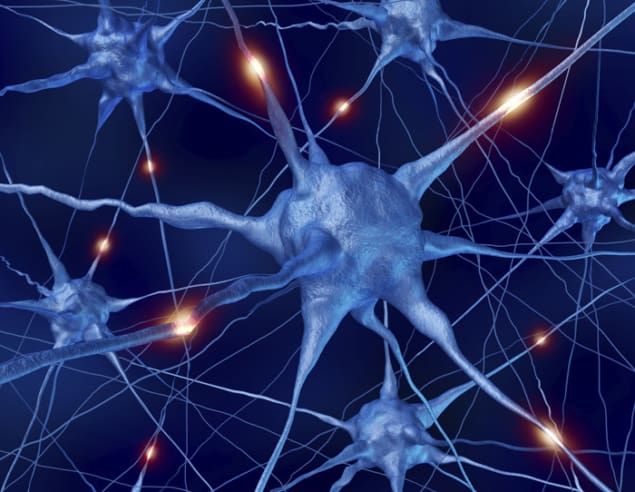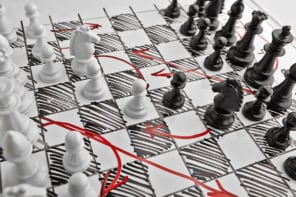
The process of losing consciousness under a general anaesthetic could involve a phase transition in the brain. That is the conclusion of scientists in the US, who have developed a new mathematical model of how the brain’s neurons interact with each other. The model shows how a small reduction in information transfer between neurons can bring about a sudden loss of consciousness, and reproduces many of the changes in the brain’s electrical activity observed during anaesthesia.
Anaesthetics are used routinely during medical procedures, so it might come as a surprise that scientists do not fully understand how they cause a patient to lose consciousness. Monitoring a person’s level of consciousness while they are being given an anaesthetic generally relies on measuring that person’s brain waves. Those waves are generated by the many electrical impulses fired between neurons, and create a measurable voltage on the scalp that can be recorded via an electroencephalogram (EEG). The correlation between waves recorded on opposite sides of the head indicates the level of consciousness, and this information is used by anaesthetists to vary the dose of anaesthetic given to the patient.
Universal phenomenon
However, this approach is very much an empirical one, and to understand how anaesthetics bring about unconsciousness, scientists have developed computer models to try and capture the underlying changes in neuronal activity. In 1997 Jamie Sleigh of the University of Auckland and Duncan Galletly of the University of Otago used a fairly simple 2D model to show how loss of awareness correlates with reduced efficiency of neural synapses. “Anaesthesia is universal for all animals with nervous systems,” says Sleigh, “which suggests that it is a very generic universal phenomenon that can be modelled at quite an abstract level.”
The latest work improves on the earlier research by modelling how information is transferred between different layers of neurons. Developed by the physicist Yan Xu and colleagues at the University of Pittsburgh, the model reproduces an electrical signal arriving at a node (either a single neuron or a group of neurons) within the thalamus region of the brain (responsible for sensory input), and then simulates the resulting signals induced in successive layers of the cerebral cortex, which is key to conscious awareness. Nodes are connected to one another across and within the layers, with the probability of information flow between them determined using percolation theory. This theory describes, among other things, how hot water flows through coffee grounds.
Ease of communication
To test their model, Xu and co-workers compared its output with EEG waveforms from patients who had undergone general anaesthesia. Regulating the amount of anaesthetic in the model meant varying the value of a single parameter – p – between 0 and 1, which changed the weighting, or the ease of communication, between connected nodes. Doing so, the researchers found they could indeed reproduce several of the main changes to the waveforms of anaesthetized individuals, including a shift to lower frequencies and higher amplitudes, as well as more synchronization between waves in different areas of the cortex and more power deposited by waves in the front of the brain.
The team also demonstrated the phase shift in sensory perception brought about by a tiny change in p. It did so by modelling how a digital image of a famous picture of Albert Einstein is transmitted through the network. The researchers showed that at p = 0.32 the light intensity recorded at the output nodes leads to a barely discernible head and crop of hair, whereas at p = 0.38 the unmistakable image of Einstein is clear.
“Master parameter”
“What is remarkable is that by changing just one master parameter, you can reproduce the most essential features of the transition from a conscious to an unconscious state,” says Xu, a professor of anaesthesiology who trained as a physicist. He proposes that experimentalists put his group’s model to the test by establishing whether – as the model predicts – unconsciousness affects which neurons are involved in the process of relearning. “We ignore a lot of biological detail but those details probably aren’t critical for consciousness to occur,” he adds. “We try to search for those universal rules that govern the emergence of consciousness.”
Peter McClintock, a physicist at Lancaster University in the UK, praises the “interesting and surprising” results, saying that although the research will be of practical benefit only if a way can be found to measure p, “improved understanding must bring us closer to better measures of depth of anaesthesia”. But he does not believe it will change our fundamental understanding of consciousness much. “I don’t think we are getting very much closer to solving the mind–body problem,” he says, “although we orbit around it ever closer as new knowledge and ideas accumulate.”
Sleigh agrees. The modelling by Xu and colleagues, he says, “clearly reflects anaesthesia–aesthesia transitions, but I am not sure that it solves the ‘hard problem’ of (human) consciousness”.
The research is reported in Physical Review Letters.



